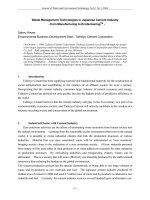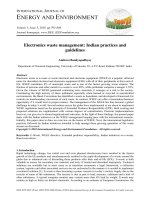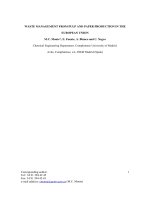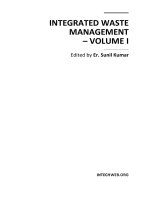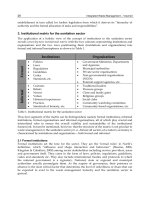Plastic waste management
Bạn đang xem bản rút gọn của tài liệu. Xem và tải ngay bản đầy đủ của tài liệu tại đây (146.48 KB, 6 trang )
11.0
Plastic Waste Management
The quantum of solid waste is ever increasing due to increase in population,
developmental activities, changes in life style, and socio-economic
conditions, Plastics waste is a significant portion of the total municipal
solid waste (MSW). It is estimated that approximately 10 thousand tons
per day (TPD) of plastics waste is generated i.e. 9% of 1.20 lacs TPD of
MSW in the country. The plastics waste constitutes two major category
of plastics; (i) Thermoplastics and (ii) Thermoset plastics. Thermoplastics,
constitutes 80% and thermoset constitutes approximately 20% of total
post-consumer plastics waste generated in India. The Thermoplastics are
recyclable plastics which include; Polyethylene Terephthalate (PET), Low
Density Poly Ethylene (LDPE), Poly Vinyal Choloride(PVC), High Density
Poly Ethylene (HDPE), Polypropylene(PP), Polystyrene (PS) etc. However,
thermoset plastics contains alkyd, epoxy, ester, melamine formaldehyde,
phenolic formaldehyde, silicon, urea formaldehyde, polyurethane,
metalised and multilayer plastics etc. The environmental hazards due to
mismanagement of plastics waste include the following aspects:
❯ Littered plastics spoils beauty of the city and choke drains and make
important public places filthy;
❯ Garbage containing plastics, when burnt may cause air pollution by
emitting polluting gases;
❯ Garbage mixed with plastics interferes in waste processing facilities
and may also cause problems in landfill operations;
❯ Recycling industries operating in non-conforming areas are posing
unhygienic problems to the environment.
11.2 Main Features of the Plastics Manufacture and Usage
(Amendment) Rules, 2003
Regulation of plastics waste, particularly manufacture and use of recycled
plastics carry bags and containers is being regulated in the country as per
“Recycled Plastics Manufacture and Usage Rules, 1999 and as amended
in 2003. According to these Rules:
❯ No person shall manufacture, stock, distribute or sell carry bags made
of virgin or recycled plastic bags which are less than 8 x 12 inches in
Recycling of plastics
should be carried
in a manner to
minimize pollution
during the process
and enhance
efficiency and
conserve the energy
139 ❙ Parivesh ❙ Central Pollution Control Board
11.1 Plastics Waste: Environmental Issues and Challenges
size and having thickness less than 20 microns.
❯ No vendor shall use carry bags/containers made of recycled plastics
for storing, carrying, dispensing or packaging of food stuffs;
❯ Carry bags and containers made of recycled plastic and used
for purposes other than storing and packaging food stuffs shall be
manufactured using pigments and colorants as per IS 9833:1981
entitled “List of pigments and colorants for use in plastics in contact
with food stuffs, pharmaceuticals and drinking water”
❯ Recycling of plastics shall be undertaken strictly in accordance with the
Bureau of Indian Standard specification: IS 14534:1998 entitled “The
Guidelines for Recycling of Plastics”
❯ Manufacturers of recycled plastic carry bags having printing facilities
shall code/mark carry bags and containers as per Bureau of Indian
Standard specification: IS 14534:1998 (The Guidelines for Recycling
of Plastics).
❯ No person shall manufacture carry bags or containers irrespective of
its size or weight unless the occupier of the unit has registered the unit
with respective SPCB/PCC prior to the commencement of production.
❯ The prescribed authority for enforcement of the provisions of these rules
related to manufacturing and recycling is SPCB in respect of States
and the PCC in Union Territories and for relating to use, collection,
segregation, transportation and disposal shall be the District Collector/
Deputy Commissioner of the concerned district
11.3 Options for Plastic Waste Management
Recycling of plastics through environmentally sound manner:
Recycling of plastics should be carried in such a manner to minimize the
pollution during the process and as a result to enhance the efficiency of
the process and conserve the energy. Plastics recycling technologies have
been historically divided into four general types -primary, secondary,
tertiary and quaternary.
Primary recycling involves processing of a waste/scrap into a product
with characteristics similar to those of original product.
Secondary recycling involves processing of waste/scrap plastics into
materials that have characteristics different from those of original plastics
product.
Tertiary recycling involves the production of basic chemicals and fuels
from plastics waste/scrap as part of the municipal waste stream or as a
segregated waste.
Quaternary recycling retrieves the energy content of waste/scrap plastics
by burning / incineration. This process is not in use in India.
Steps Involved in the Recycling Process
Selection: The recyclers / reprocessors have to select the waste / scrap
which are suitable for recycling /reprocessing.
Segregation: The plastics waste shall be segregated as per the Codes
1-7 mentioned in the BIS guidelines (IS:14534:1998).
140 ❙ Parivesh ❙ Central Pollution Control Board
Processing: After selection and segregation of the pre-consumer waste
(factory waste) shall be directly recycled. The post consumer waste (used
plastic waste) shall be washed, shredded, agglomerated, extruded and
granulated
11.4 Polymer Coated Bitumen Road
The CPCB has undertaken a project in collaboration with Thiagarajar
College of Engineering Madurai to evaluate the performance of polymer
coated built roads laid during 2002-2006 in different cities.
The observations are as below:
❯ The coating of plastics over aggregate improves Impact, Los Angels
Abrasion and Crushing Value with the increase in the percentage of
plastics.
❯ The extracted bitumen showed almost near value for Marshall stability.
The entire road was having good skid resistance and texture values.
❯ All the stretches in the roads have been found reasonably strong.
❯ The unevenness index values of these roads are nearly 3000 mm/km,
which indicate a good surface evenness.
❯ The plastic tar roads have not developed any potholes, rutting, raveling
or edge flaw, even though these roads are more than four years of age.
❯ Polymer coated aggregate bitumen mix performs well compared to
polymer modified bitumen mix.
❯ Higher percentage of polymer coating improves the binding strength
of the mix.
❯ Foam plastics have better binding values.
Plastic waste
disposal through
Plasma Pyrolysis is
a state of the art
technology, which
integrates the
thermo-chemical
properties of plasma
with the pyrolysis
process
11.5 Plastics waste disposal through Plasma Pyrolysis
Technology (PPT)
Plasma Pyrolysis Technology
In plasma pyrolysis, firstly the plastics waste is fed into the primary
chamber at 8500C through a feeder. The waste material dissociates into
carbon monoxide, hydrogen, methane, higher hydrocarbons etc. Induced
draft fan drains the pyrolysis gases as well as plastics waste into the
secondary chamber, where these gases are combusted in the presence
of excess air. The inflammable gases are ignited with high voltage spark.
The secondary chamber temperature is maintained at around 10500 C.
The hydrocarbon, carbon monoxide and hydrogen are combusted into
safe carbon dioxide and water. The process conditions are maintained
so that it eliminates the possibility of formation of toxic dioxins and
furans molecules (in case of chlorinated waste). The conversion of
organic waste into non toxic gases (CO2, H2O) is more than 99% . The
141 ❙ Parivesh ❙ Central Pollution Control Board
Plasma Pyrolysis is a state of the art technology, which integrates the thermochemical properties of plasma with the pyrolysis process. The intense and
versatile heat generation capabilities of PPT enable it to dispose off all
types of plastic wastes including polymeric, biomedical and hazardous
waste in a safe and reliable manner.
extreme conditions of Plasma kill stable bacteria such as Bacillus stereothermophilus and Bacillus subtilis immediately. Segregation of the waste
is not necessary, as very high temperatures ensure treatment of all types
of waste without discrimination.
The CPCB has initiated the study in association with Facilitation Centre
for Industrial Plasma Technologies (FCIPT), Institute of Plasma Research
(IPR) The objectives of the study are to conduct performance study of the
PPT on 15 kg/hr prototype demonstration system developed by FCIPT/
IPR for proper disposal of plastics waste and also monitor air quality
parameters e.g. suspended particulate matter (SPM), carbon monoxide
(CO), hydrocarbons (HC), benzene, dioxins, furans etc. with regards
to gaseous emissions. CPCB also proposes to undertake study on safe
disposal of plastics waste using higher capacity (approx. 50 kg/hr) plasma
pyrolysis system as in future and may set up prototype plasma pyrolysis
plant on demonstration basis (15 kg/hr waste disposal capacity) at specific
locations (hilly and pilgrimage) in consultation with State Government.
11.6 Conversion of Plastics waste into Liquid Fuel
A research-cum-demonstration plant was set up at Nagpur, Maharashtra
for conversion of waste plastics into liquid fuel. The process adopted is
based on random de-polymerization of waste plastics into liquid fuel
in presence of a catalyst. The entire process is undertaken in closed
reactor vessel followed by condensation, if required. Waste plastics while
heating upto 2700 C to 3000 C convert into liquid-vapour state, which is
collected in condensation chamber in the form of liquid fuel while the tarry
liquid waste is topped-down from the heating reactor vessel. The organic
gas is generated which is vented due to lack of storage facility. However,
the gas can be used in dual fuel diesel-generator set for generation of
electricity. The process includes the steps shown ahead:
142 ❙ Parivesh ❙ Central Pollution Control Board
Environment related observations during the process
❯ There are no liquid industrial effluents and no floor washings as it is a
dry process.
❯ There are no organized stack and process emissions.
❯ Odour of volatile organics has been experienced in the processing
area due to some leakages or lack of proper sealing
❯ Absolute conversion of liquid-vapour was not possible into liquid, some
portion of gas (about 20%) is connected to the generator. However,
the process will be improved in full-scale plant.
❯ PVC plastics waste is not used and if used, it was less than 1%. In case
PVC is used, the chlorine can be converted into hydrochloric acid as
a by-product.
❯ The charcoal (charcoal is formed due to tapping of tarry waste) generated
during the process has been analysed and contain heavy metals, poly
aromatic hydrocarbon (PAH) which appears to be hazardous in nature.
The source of metals in charcoal could be due to the presence of
additives in plastics and due to multilayer and laminated plastics.
❯ Monitoring of process fugitive emissions in the work area as well as
emissions from the engines/diesel generator sets is necessarily required
(where this liquid fuel is used) for various parameters such as CO, HCl,
Styrene, Benzene, VOCs.
Environmentally
degradable
polyolefin films
are those materials
that degrade under
conditions of
composting
The environmentally degradable polyolefin films are defined as those
materials that contain degradation process of polyolefin article (bag/film/
sheet) under conditions of composting. Often queries are raised regarding
biodegradability of plastics but clear-cut answer is not available about
the biodegradability of plastics. In view of above, CPCB has initiated a
study in collaboration with Central Institute of Plastics Engineering and
Technology (CIPET) to establish the biodegradability and compostability
(e.g. fragmentation rate, degradation rate and safety) of polymeric
material available in India and abroad. The study will include:
❯ Inventorisation and assessment of the manufacturing status of
biodegradable plastics in India particularly with reference to processing
technologies and the environmental issues.
❯ Establishment of the degradation rate (change in chemical structure,
decrease in mechanical strength, fragmentation or weight loss) of
the polymeric material or plastics material under laboratory scale
composting conditions
❯ Finding out self-life and its impact on environment (soil, water of plastics
with reference to colour and additives, once it is disposed off)
❯ Assessment of effects on foodstuffs with reference to natural colours
and additives
143 ❙ Parivesh ❙ Central Pollution Control Board
11.7 Biodegradable Plastics
